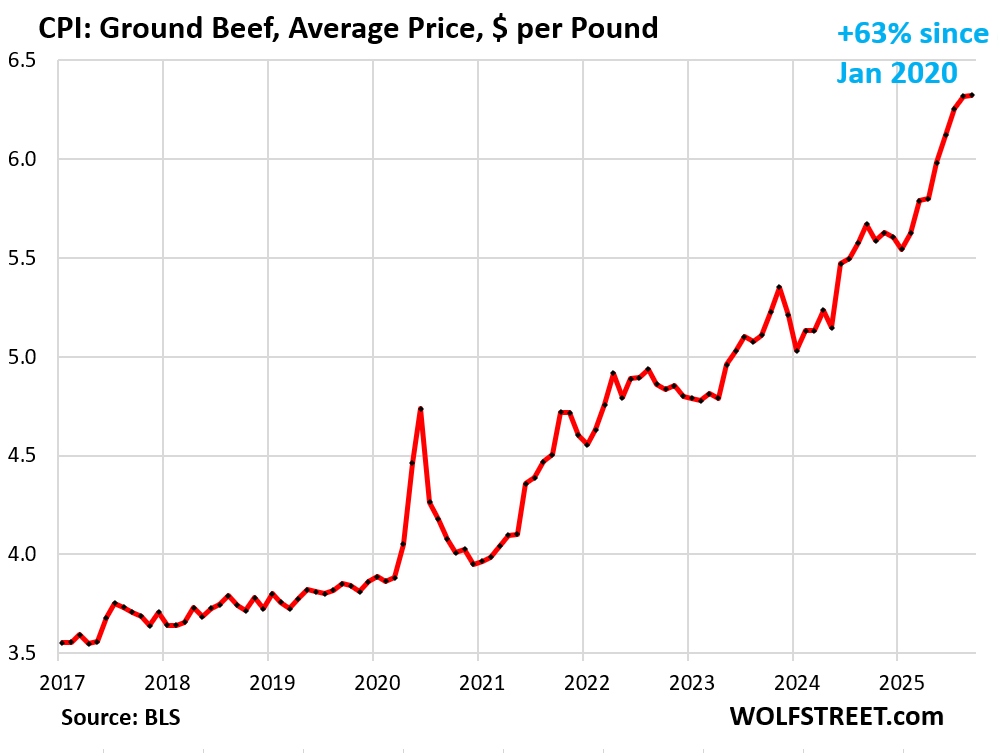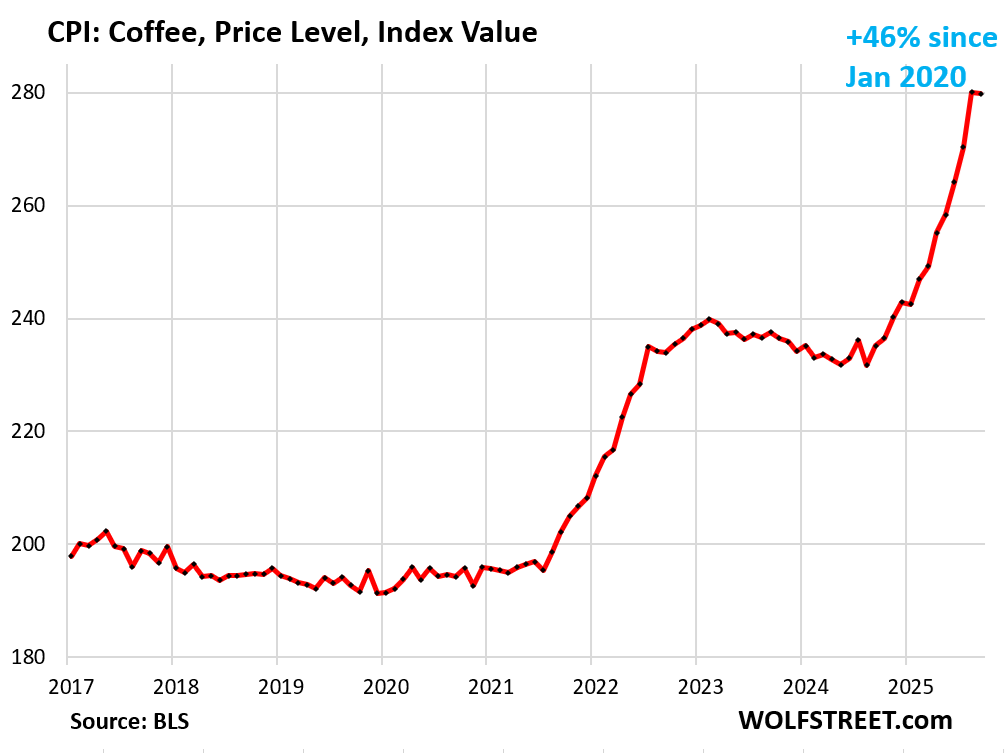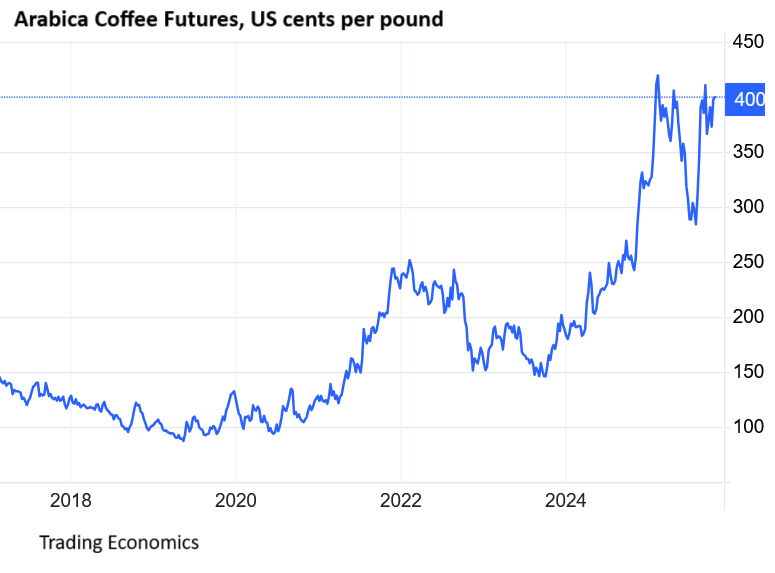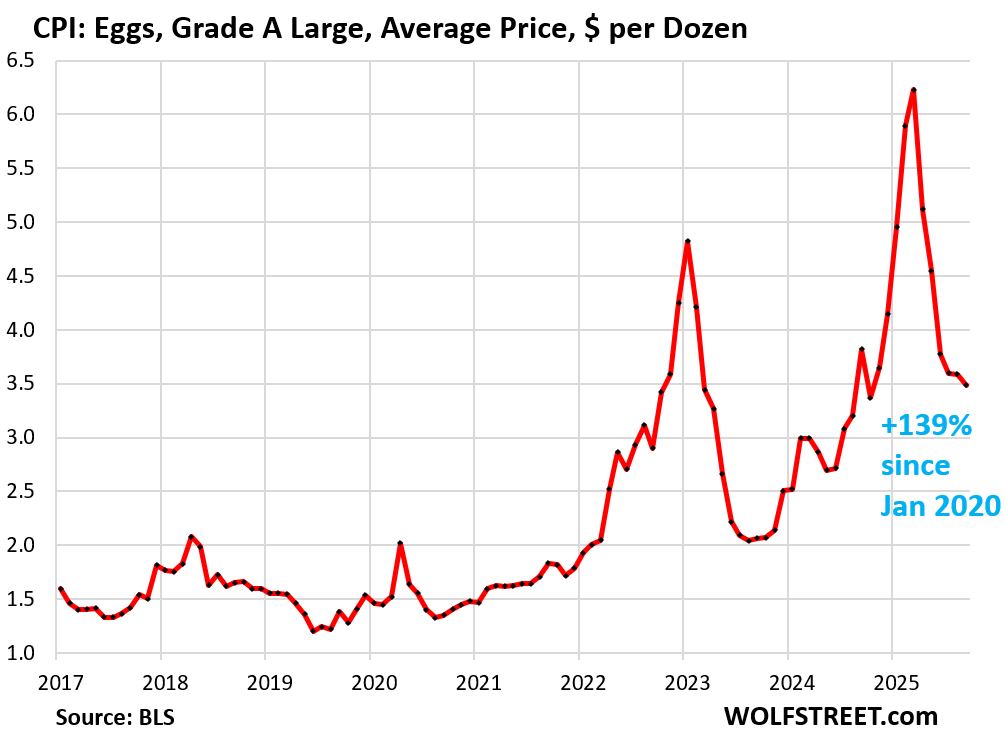Yves here. Wolf Richter has two informative pieces on the latest inflation data. His companion post, Massive Outlier in Owner’s Equivalent of Rent Pushed Down CPI, Core CPI, Core Services CPI: Something Went Awry at the BLS, looks at where there was figures-fixing that had the effect of lowering the reported key inflation measures. This one looks at the continuing pain of food price increases.
By Wolf Richter, editor at Wolf Street. Originally published as Wolf Street
The CPI inflation index for “Food at home” rose by 0.32% in September from August (4.0% annualized), and by 2.7% year-over-year, the worst increase since August 2023, as per the data released belatedly by the Bureau of Labor Statistics today. Since January 2020, the CPI for food at home has surged by 30%.
The CPI “Food at home” tracks numerous categories of food and drinks that consumers purchase at stores and markets and consume off-premise, such as at home. But their prices don’t march in lockstep. Egg prices have re-plunged for months off their avian-flu spike and continued to drop in September. But beef prices soared. Coffee prices dipped off the huge spike. And dairy has been plateauing at very high levels. Hundreds of food and drink items form the overall food at home CPI.
This chart shows the price level of the CPI food at home: A surge in 2021 through 2022, a tiny dip in early 2023, and then continued but slower price increases that started re-accelerating in mid-2024. By now, prices of food at home have risen by 30% since early 2020.

Beef prices have been soaring for five years, as the US cattle herd has dropped to a 64-year low for a number of reasons, causing tight supply. Americans’ demand for beef despite high prices has continued to push prices even higher. Americans gripe, moan, and groan about high beef prices, but don’t give up on their beef easily.
Overall beef prices spiked by 1.2% in September from August, and by 14.7% year-over-year. But there are signs that the multi-year surge is beginning to slow.
For example, the average price of ground beef, which had exploded by 63% since the beginning of 2020, ticked up only 0.1% in September from August, which got lost as a rounding error, and the price per pound remained at $6.32.

The CPI for roasted coffee – includes roasted whole bean, ground, and instant coffee – dipped by 0.1% in September from August, after the multi-year spike that came in two phases, roughly following with some lag global commodity prices of green coffee beans:
- +22% from Jul 2021 to Feb 2023
- +21% from Aug 2024 to Aug 2025.
Since January 2020, the CPI for coffee spiked by 46%.

Green coffee beans, as a global commodity product, are traded on various platforms, and prices are very volatile, often driven by fears of droughts, bad harvests, market forces, and now tariffs.
For example, Arabica coffee futures prices (chart below via Trading Economics):
- +150% from mid-2020 – early 2022
- Then they gave up part of that spike.
- +125% from late 2023 – late 2024.
- In 2025, they spiked, plunged, and re-spiked and are now just below where they’d been in early February, as futures markets reacted strongly to tariff announcements.
These are violent price movements that don’t pass through to retail prices of roasted coffee. Since early 2020, coffee futures exploded by 300% while the CPI of roasted coffee sold by retailers rose 46% over the same period.

Egg prices have now collapsed after the spikes, but are still high. The avian flu came in two waves, the first in 2022 and the second in 2024, each triggering shortages of eggs, empty shelves, purchase restrictions when eggs were available, and huge price spikes.
The average price of Grade A Large Eggs had soared by 368% from $1.33 per dozen in mid-2020 to $6.23 at the peak of the second wave in March 2025. Since then, prices have plunged.
In September, they continued to fall, -2.8% for the month, to $3.49 per dozen Grade A large eggs, according to the BLS today. They have now plunged by 44% from the March peak, but are still 146% more expensive than they had been in mind-2020.

Dairy and related products were another shocker during the high inflation years of 2020 to 2022, when they spiked by 22%, and prices have remained at these high levels since then.
The CPI for dairy and related products declined by 0.5% in September from August, according to the BLS today. Year-over-year, it rose by 0.7%.

Major Categories of CPI Food at Home
Beef, coffee, eggs, and dairy are among the most volatile food categories. But there were other categories with price spikes, all for their own reasons. For example, prices of baby formula spiked in 2022 and 2023, amid shortages, suddenly putting enormous pressure on families with young children, while other consumers never noticed it.
The category “Coffee, tea, etc.” in the table below also includes tea and “other beverage materials.” The CPI for coffee shown in the chart above is just for coffee (ground, whole-bean, instant).
The category “Beef and veal” in the table is far broader than ground beef, the example in the chart above.
The category “Eggs” includes all types of eggs, not just Grade A large depicted in the chart above.
| MoM | YoY | |
| Food at home | 0.3% | 2.7% |
| Cereals, breads, bakery products | 0.7% | 1.6% |
| Beef and veal | 1.2% | 14.7% |
| Pork | 0.5% | 1.6% |
| Poultry | 0.1% | 1.4% |
| Fish and seafood | -0.3% | 2.1% |
| Eggs | -4.7% | -1.3% |
| Dairy and related products | -0.5% | 0.7% |
| Fresh fruits | -0.5% | -0.2% |
| Fresh vegetables | 0.0% | 2.8% |
| Juices and nonalcoholic drinks | 1.4% | 3.1% |
| Coffee, tea, etc. | -0.1% | 18.9% |
| Fats and oils | 0.3% | -1.7% |
| Baby food & formula | 1.3% | 0.6% |
| Alcoholic beverages at home | 0.0% | 0.3% |
Rising and spiking food prices, and these continued high food prices after a spike, cause a lot of hardship among consumers that aren’t rich who suddenly have to make all kinds of compromises to put food on the table. Food prices are nothing to be trifled with.


There is a political take from those charts. When you look at them, prices started spiking after 2020 when Biden came in. And it wrecked the Democrats when Biden was saying how great the economy was going when Americans could feel the crunch whenever they went shopping, If anything, he was dismissive of the inflation pushing up food prices. Whatever the causes of all those spikes, I would suggest that Biden could have tried to do something about those food prices but that there was no political will to do so and I do not think that he even cared. He had more important things on his mind – the Ukraine and Israel – so just fobbed off those rising food prices.
May be these spikes had to do with food chains more or less broken by the pandemic though, interestingly, nothing (except eggs and Arabica coffee according to graphs) went somehow back to normal when the pandemic was officially declared over. This is nothing exceptional for the US and recent food inflation in Spain, and many other places as well, has been awful as i note @ the supermarket. Thing is that in this crazy world it seems some, or many, are rising to the occasion and rising prices who knows with which substantive or not-so-substantive causes (fertilizers, extreme weather events, monopolies, tariffs, collusion, greed, whatever) behind. Problem is that, like it happens with the electricity markets, good analysis on pricing drivers are missing or difficult to find. Whether this is because nobody, or few, have incentives to do it, or publish it when it contradicts our narratives or policies or whatever spurious reason (for instance biased internet search engines) is something to note. Policymakers may be very much kept in the dark like the rest of us. Chaotic world is this and some may be taking advantage of it.
I would add that if the policy makers are not getting good info that’s their fault.
There is great info out there but it might not align with their policies or beliefs.
Take Biden who knows what he knew or believed or what he was told by his advisors, and while it’s hard to fault him for covid issues, he didn’t handle it well. And to push he was great on the economy “bidenomics” was I think a reason the Dems failed in the election as being so out of touch.
For example with energy the majority of reports for the US point to lack of transmission as a major cause of expense due to congestion pricing.
See this report.
https://www.construction-physics.com/p/whats-happening-to-wholesale-electricity
Remember Enron? Prices have been manipulable to such degree as long as the political support for manipulation exists.
I remember. I lived in Seattle at the time and our electric rates spiked. Turn on the news and they were telling us that the rate increases were due to a drought that limited hydroelectric production. I looked out my window and saw the normal wet, rainy conditions. Not long after, the Enron scandal broke and it became abundantly clear why rates really spiked.
When you’re getting the runaround, believe your own lying eyes.
Supply and demand. Drive out smaller producers. Consolidate. Monopoly pricing power. Look at the WolfStreet price chart and the year the big jump began. Heck of a coincidence.
LIST of All Food Processing Plants That Have Burned Down,
Blown Up, or Destroyed Under US Government of 2021 to 2022
https://mbeinstitute.org/ap/treat/1-7/control/asleep-or-awake/list-of-96-food-processing-plants-burned-down-blown-up-or-destroyed-by-us-government-from-2021-to-2022-240206-1418.pdf
I’ve read that almost all supermarket beef now distributed by five companies. At my nearby Aldi a worker seen restocking the store brand chicken section from boxes marked Tyson. At our Asheville based traditional chain the chicken is openly sold as Tyson but in different style packaging.
But all of this was probably true before 2020 when food prices were arguably quite low. The Covid disruptions seem to have provided the excuse to keep prices high. After all who is stopping them?
Meanwhile on the retail level competition still exists and the discount groceries seem to be surging.
Yes, meatpacking is massively consolidated. Egg hens are a monopoly owned by a German company. We are being fleeced massively, before you factor in global warming and its destruction of 90% of Florida Citrus
Ahem. That document does NOT list 96 food processing plants burned down, etc… despite the overly sensational title.
57 entries in the list are of poultry culling, no doubt in an attempt to control the H5N1 virus – remember that ? Hasn’t gone away.
So the remaining 39 entries are actual processing plants lost ?
Forgive me if I’m a little skeptical at this point.
Or check this list of destroyed food producers or processing plants.
He writes in the introduction:
“In case we forget the apparent systematic destruction of food production facilities in the United States, this list should refresh the readers memory…
In all of 2021 there were only 10 fire/destruction events of food production systems in the entire United States.
In the first half of 2022, there have been 87 fire/destruction events of food production facilities.”
Here’s the missing link. / ;)
https://www.jerrywdavis.com/2021-2022-usa-food-production-destruction-numbers-dates-locations-links/
Enough to make a person question the explosion of coincidences.
Third time and beyond is enemy action. Insurance fires or systematic destruction.
And that seems to include most of the poultry culling events from the document you linked previously, which are NOT “destruction of food production facilities“.
Are you arguing that those cullings were not part of the effort to contain H5N1 bird flu, but were instead part of some plot to reduce the food supply in the US ?
Whether or not it’s true, my brother/sister-in-law believe this and bring it up around Thanksgiving dinner times. It’s been part of the right-wing media-verse since ’21 or so.
Absolutely amazing how many poultry were destroyed due to bird flu. Otherwise 2021 and 2022 would be similar in destruction.
Auto insurance is not included but worth passing along….South Carolina version so indeed others mileage may vary. Next installment of the six month premium billing is at long last, slightly on the decline. May to November of 2025 it was pushing at $ 775 for six months, and now the November to May 2026 is about $710. I really could drop the comprehensive to save a little more.
Very old car but not a relic, 2008 Accord that I’ll keep running and maintain until it leaves no choice ( like oh, a full transmission must be replaced ). Might get driven about 10,000 mi!es per year since 2021.
That generation of Accord literally is one of the best-built cars from that time period. Regular maintenance (fluid changes, belt changes, wear items—like starter—as need) and that car will outlive all of us—until gasoline cars are banned, lol.
Can’t recall the price of a refurbished Accord transmission—-but it’ll beat looking for a new car or a new used-car/
I wish that we never sold ours and kept it like a car hoarder. On many new cars, it is ridiculously, needlessly difficult to service transmission fluid. But on that Accord, it is ridiculously simple.
Yep I’ve got a 2005, took it to the Honda dealer for an electrical gremlin (just got a bad battery from autozone that was behaving oddly, thankfully), and the tech told me it looked better mechanically than a lot of new cars he sees.
Bubble era Japanese cars are a miracle and need to be Cherished. I’d be much broker without mine
Well..I did experience a bad cylinder around 180,000 miles and so the engine got practically rebuilt along with fully replacing the water pump and timing belt. I had the resources and the ability to fund those expensive repairs in late 2019.
Overall still pretty content with the car since that time, and in the subsequent years there were a few other less costly , but still very notable, repairs or full replacement.
I’m over 231k miles on my Tacoma, bought off the lot with 14 miles in 2010.
That’s what I do, buy ’em new and run ’em into the ground, and never having run a jalopy so far in such a fashion, i’m a little anxious to move on, but there’s a little hitch in my giddyup in that Toyota in their wisdom, got rid of the bulletproof V6 and replaced it with a V4 with turbo boost, that everybody seems to despise to the point that it is raising pre-2024 used Tacoma prices in retaliation against the new model.
The $4995 pickup truck was once upon a time when I was a young adult.
Broader issue is long-term cyclical distress in insurance markets, from cars to homes to health to whatever. /:
Some rational insurance commissioners would be a good start, nudging Congress on the elements the latter influences like health insurance, and maybe even some competition instead of sole provisioners.
I have often wondered how much car insurance rates would drop if there were single-payer healthcare…
Imagine life without a car. In July I celebrated my 10-year anniversary of not having a car. It’s very convenient in a city like Montevideo, in fact far more convenient than owning a car.
A day and a decade late here, but I’ve got a 1998 Civic HX, I bought it new (with cash, when I had that sort of means). It still runs (and looks, I care for it) great. Built in Marysville Ohio, it’s not quite as perfectly fit as the 1990 CRX it replaced (a powered roller skate, I grew frightened at watching the undersides of the behemoths passing me on the highway), but still superb. I have no idea what I would replace it with, even if I could. I get 36 mpg city, 48 highway, not as good as the CRX which got 59 mpg no matter what, but still….
It would be interesting to see a breakdown of food prices in California, as they appear significantly higher than the nationwide average. This is despite the fact that CA produces the most ag in the country. Staples like bread, milk, eggs, fruit, veg. etc are higher. For example, I went to Safeway recently and eggs were almost double what the chart here says.
The cheapest gasoline in town is $4.59/gal. PG&E electricity rates are supposedly around 50 cents per Kwh, but my bill says almost double that if we include the final price of generation and distribution.
It looks like we are getting gouged hard, because average income is higher here. Taxes and regs I’m sure add to the mix as well, but the gouge is on. Want food? Want electricity? Just pay the extortion, as usual. Just like health care, necessities are used to extort the public.
California produces more milk than “cheese-head” Wisconsin. I’m not in California, and it regularly surprises me how much milk costs when I visit other grocery stores during vacation.
for me, 1 gallon of regular milk is $2.25 at Costco; $2.79 – $2.99 at the traditional grocery stores. Store-brand organic is $6.99/gal at the traditional grocery stores.
True, I just paid 5.49 for a gallon of whole milk (non organic) at Safeway in northern Cal., the cheapest they have (Lucerne brand). The milk is produced in Sonoma County, less than 100 miles away from where I live.
Neighborhood stores are typically much higher as they don’t sell enough volume to get better pricing.
Food deserts? Fuhgeddaboutit.
I’ve helped a number of people in Cali review their bill. And I’ve never seen one more than $.50 kwh.
I just was looking at one in the santa cruz area, came out to $.45 kWh. total cost divided by kWh for the month. $203 and 449 kWh.
Its still stupid expensive.
Thanks, I must have misunderstood the bill: In my area the electricity is generated from Sonoma Clean Power and PG&E is the distribution. PGE sends the bills and are confusing – I’ll just divide like you did, but I think mine is still more than .45/kwh. As you say, it’s still stupid expensive
Yup they make the bills totally difficult to understand on purpose
They add stuff and then 2 lines down they subtract stuff. Super confusing
Electricity in Uruguay is considered very expensive: 0.34 usd per kwh
Food is bad. I am stabilized so rent only went 4.5% this month for the lease renewal. But electrical…
I haven’t done the calculation to give the exact multiplier, but my most recent Con Ed bill had taxes and distribution fees that were less than two times but more than 1.5 times the cost of the electricity itself. After large increases over the last year and a half, Con Ed wants another double digit increase for the start of 2026.
I haven’t had the guts to check out the premium increases for my health coverage yet.
I am pretty sure that most of our rulers, regardless to which side of the Uniparty they claim allegiance, have spent little or no time in a grocery store, agonizing over their utility bills, or searching for pennies to keep a roof over their head. That makes it much easier to deny inflation is rampant
Trump says inflation has been ‘tamed’, so all those graphs must be fake!! Hah!